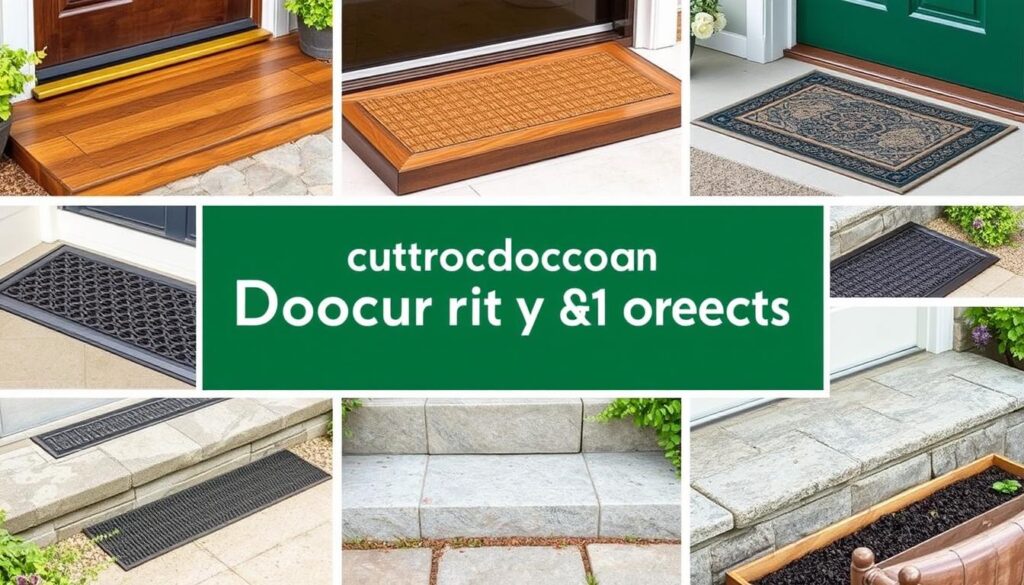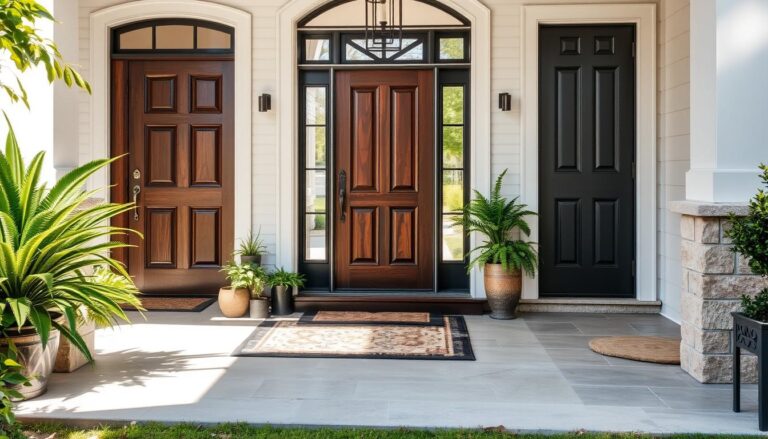Exterior door thresholds are key to your home’s look and feel. They act as a bridge between the outside and inside. They also protect your home from the weather and add to your entryway’s style.
There are many materials to choose from, like aluminum, wood, and composite. Each has its own benefits and upkeep needs. Picking the right one can make your entryway look better and keep your home safe.
Door thresholds are more than just a practical item. They can also make your home look better from the outside. The right material can make your home’s inside and outside look connected. It also keeps your home safe from the weather. Knowing your options is important when you need a new threshold or want to update your current one.
Understanding Exterior Door Thresholds and Their Types
Choosing the right exterior door threshold is important. You need to think about durability, style, and how easy it is to maintain. There are many types, like aluminum, wooden, and composite thresholds. Each has its own special features, so it’s key to pick the one that fits your home best.
Aluminum thresholds are tough and don’t rust, making them a favorite among homeowners. They look sleek and modern, even in bad weather. Wooden thresholds, however, offer a classic look. You can stain or paint them to match your home’s style, adding warmth and beauty to your entryway.

Composite thresholds are a modern choice. They mix materials to create something strong and easy to care for. They resist rot, decay, and bugs. Here are some benefits of each type:
- Aluminum thresholds: durable, corrosion-resistant, and low maintenance
- Wooden thresholds: traditional look, can be stained or painted, and adds warmth to the entryway
- Composite thresholds: modern solution, durable, low maintenance, and resistant to rot and decay
Durability and Style
When picking a door threshold, think about both how long it lasts and how it looks. Aluminum and composite thresholds are good for those who want something strong. Wooden thresholds are perfect for a classic look. Your choice should match your style, budget, and how much you want to maintain it.
Professional Installation Guidelines for Door Thresholds
Installing an exterior door threshold requires precision. Experts say to follow professional guidelines for a good fit and function. Start by preparing the area. This means removing the old threshold, cleaning the surface, and applying adhesive.
Measuring the doorway accurately is a key step. This ensures the threshold fits perfectly. Some thresholds need cutting for a precise fit. Then, fasten the threshold to the floor and seal any gaps to keep water out.
Following these guidelines can make your entryway look better. It also protects your home from water damage and reduces slip and fall risks.
Some important things to consider during installation include:
- Ensuring the threshold is level and securely fastened
- Applying a suitable adhesive to the surface
- Sealing any gaps to prevent water infiltration
By focusing on these details, homeowners can achieve a successful installation.
Professional guidelines highlight the importance of a well-installed threshold. It keeps your home safe and intact. By choosing the right materials and following maintenance tips, your entryway will stay secure and attractive for years.
Maintaining Your Exterior Door Thresholds
Keeping your exterior door thresholds in good shape is key. This means cleaning, checking for damage, and fixing problems fast. By using seasonal maintenance tips, your threshold will keep working well.
Start by cleaning your threshold often to get rid of dirt and debris. Look for any damage or wear and apply a protective coat to keep it safe from the weather. Issues like rot, decay, or damage from heavy use can often be fixed with small repairs or by replacing damaged parts.
- Clean your threshold regularly to prevent dirt and debris buildup
- Inspect for damage or wear, and address issues promptly
- Apply a protective coating to shield your threshold from the elements
By sticking to these tips and keeping up with threshold maintenance, you can make your exterior door threshold last longer. This helps avoid bigger problems like water damage or structural issues.
Conclusion: Making the Right Choice for Your Entryway
Choosing the perfect exterior door threshold is key to a great entryway. There are many materials and styles to pick from. It’s important to think about what each one offers to make the right choice for you.
Wood thresholds offer classic beauty, aluminum is strong and durable, and composite materials are modern and low-maintenance. The goal is to find one that looks good with your home and keeps it safe from the weather. Knowing how to install and care for it will make it last longer.
The right exterior door threshold can make your home look better, keep it safe, and last for years with little care. By choosing wisely, you can make an entryway that shows off your style and makes your home more comfortable and secure.
FAQs – Exterior Door Thresholds
What are the different types of exterior door thresholds?
Exterior door thresholds come in three main types: aluminum, wood, and composite. Each has its own strengths in durability, style, and upkeep.
What are the benefits of aluminum thresholds?
Aluminum thresholds are tough and don’t rust. They look sleek and modern. Plus, they need little care, making them a favorite among homeowners.
How do wooden thresholds differ from other materials?
Wooden thresholds add a classic touch and can be painted or stained. But, they need more care to avoid rot and decay than other options.
What are the advantages of composite thresholds?
Composite thresholds are strong and easy to keep up. They resist rot, decay, and bugs. This makes them a smart, modern choice for door thresholds.
What are the key steps for professional installation of an exterior door threshold?
For a pro install, start by getting the area ready. Then, measure the doorway right. Next, secure the threshold well and seal any gaps to block water. This ensures a good fit and lasting performance.
How should I maintain my exterior door threshold?
Keep your threshold clean and check for damage often. Fix any problems quickly. Seasonal upkeep and knowing how to handle common issues will keep your threshold in great shape.
When should I consider replacing my exterior door threshold?
Replace your threshold if it’s badly damaged, like rotting or heavily worn. You might also need a new one if it’s old or not keeping out the weather well.


